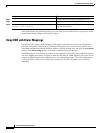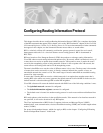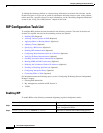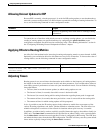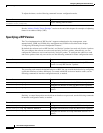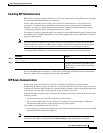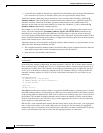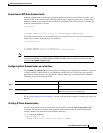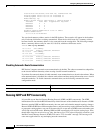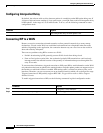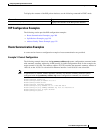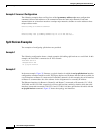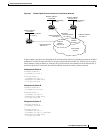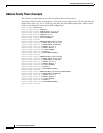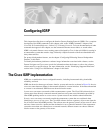
Configuring Routing Information Protocol
RIP Configuration Task List
IPC-206
Cisco IOS IP Configuration Guide
Invalid after 180 seconds, hold down 180, flushed after 240
Outgoing update filter list for all interfaces is
Incoming update filter list for all interfaces is
Redistributing: rip
Default version control: send version 2, receive version 2
Interface Send Recv Triggered RIP Key-chain
Ethernet2 2 2
Ethernet3 2 2
Ethernet4 2 2
Ethernet5 2 2
Automatic network summarization is not in effect
Address Summarization:
10.11.0.0/16 for Ethernet2
You can check summary address entries in the RIP database. These entries will appear in the database
only if relevant child routes are being summarized. When the last child route for a summary address
becomes invalid, the summary address is also removed from the routing table. The following example
shows a summary address entry for route 10.11.0.0/16, with three child routes active:
router# show ip rip database
10.0.0.0/8 auto-summary
10.11.11.0/24 directly connected, Ethernet2
10.1.0.0/8 auto-summary
10.11.0.0/16 int-summary
^^^^^^^^^^^^^^^^^^^^^^^^^^^
10.11.10.0/24 directly connected, Ethernet3
10.11.11.0/24 directly connected, Ethernet4
10.11.12.0/24 directly connected, Ethernet5
Disabling Automatic Route Summarization
RIP Version 2 supports automatic route summarization by default. The software summarizes subprefixes
to the classful network boundary when crossing classful network boundaries.
If you have disconnected subnets, disable automatic route summarization to advertise the subnets. When
route summarization is disabled, the software sends subnet and host routing information across classful
network boundaries. To disable automatic summarization, use the following command in router
configuration mode:
Running IGRP and RIP Concurrently
It is possible to run Interior Gateway Routing Protocol (IGRP) and RIP concurrently. The IGRP
information will override the RIP information by default because of the administrative distance of IGRP.
However, running IGRP and RIP concurrently does not work well when the network topology changes.
Because IGRP and RIP have different update timers, and because they require different amounts of time
to propagate routing updates, one part of the network will accept and use IGRP routes and another part
will accept and use RIP routes. Running IGRP and RIP concurrently will result in routing loops. Even
though these loops do not exist for very long, the time-to-live (TTL) value will quickly reach zero, and
Internet Control Message Protocol (ICMP) will send a “TTL exceeded” message. This message will
cause most applications to stop attempting network connections.
Command Purpose
Router(config-router)# no auto-summary
Disables automatic summarization.



